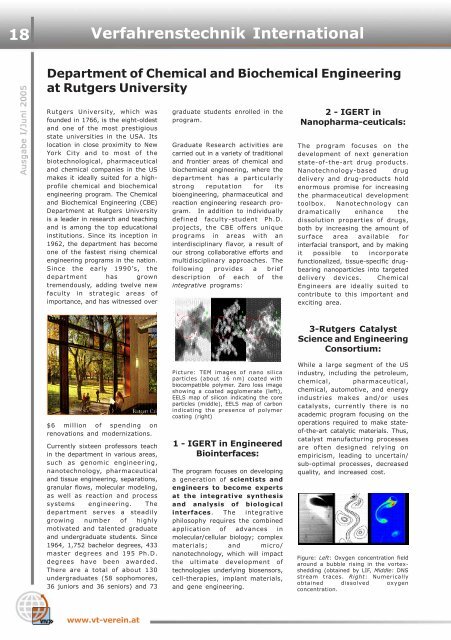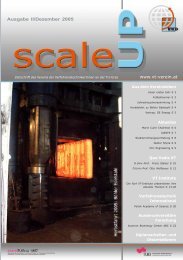Zeitschrift Juni_2005_Version_AA_5 - Verein der ...
Zeitschrift Juni_2005_Version_AA_5 - Verein der ...
Zeitschrift Juni_2005_Version_AA_5 - Verein der ...
Erfolgreiche ePaper selbst erstellen
Machen Sie aus Ihren PDF Publikationen ein blätterbares Flipbook mit unserer einzigartigen Google optimierten e-Paper Software.
18<br />
Verfahrenstechnik International<br />
Department of Chemical and Biochemical Engineering<br />
at Rutgers University<br />
Rutgers University, which was<br />
founded in 1766, is the eight-oldest<br />
and one of the most prestigious<br />
state universities in the USA. Its<br />
location in close proximity to New<br />
York City and to most of the<br />
biotechnological, pharmaceutical<br />
and chemical companies in the US<br />
makes it ideally suited for a highprofile<br />
chemical and biochemical<br />
engineering program. The Chemical<br />
and Biochemical Engineering (CBE)<br />
Department at Rutgers University<br />
is a lea<strong>der</strong> in research and teaching<br />
and is among the top educational<br />
institutions. Since its inception in<br />
1962, the department has become<br />
one of the fastest rising chemical<br />
engineering programs in the nation.<br />
Since the early 1990’s, the<br />
department has grown<br />
tremendously, adding twelve new<br />
faculty in strategic areas of<br />
importance, and has witnessed over<br />
graduate students enrolled in the<br />
program.<br />
Graduate Research activities are<br />
carried out in a variety of traditional<br />
and frontier areas of chemical and<br />
biochemical engineering, where the<br />
department has a particularly<br />
strong reputation for its<br />
bioengineering, pharmaceutical and<br />
reaction engineering research program.<br />
In addition to individually<br />
defined faculty-student Ph.D.<br />
projects, the CBE offers unique<br />
programs in areas with an<br />
interdisciplinary flavor, a result of<br />
our strong collaborative efforts and<br />
multidisciplinary approaches. The<br />
following provides a brief<br />
description of each of the<br />
integrative programs:<br />
2 - IGERT in<br />
Nanopharma-ceuticals:<br />
The program focuses on the<br />
development of next generation<br />
state-of-the-art drug products.<br />
Nanotechnology-based drug<br />
delivery and drug-products hold<br />
enormous promise for increasing<br />
the pharmaceutical development<br />
toolbox. Nanotechnology can<br />
dramatically enhance the<br />
dissolution properties of drugs,<br />
both by increasing the amount of<br />
surface area available for<br />
interfacial transport, and by making<br />
it possible to incorporate<br />
functionalized, tissue-specific drugbearing<br />
nanoparticles into targeted<br />
delivery devices. Chemical<br />
Engineers are ideally suited to<br />
contribute to this important and<br />
exciting area.<br />
$6 million of spending on<br />
renovations and mo<strong>der</strong>nizations.<br />
Currently sixteen professors teach<br />
in the department in various areas,<br />
such as genomic engineering,<br />
nanotechnology, pharmaceutical<br />
and tissue engineering, separations,<br />
granular flows, molecular modeling,<br />
as well as reaction and process<br />
systems engineering. The<br />
department serves a steadily<br />
growing number of highly<br />
motivated and talented graduate<br />
and un<strong>der</strong>graduate students. Since<br />
1964, 1,752 bachelor degrees, 433<br />
master degrees and 195 Ph.D.<br />
degrees have been awarded.<br />
There are a total of about 130<br />
un<strong>der</strong>graduates (58 sophomores,<br />
36 juniors and 36 seniors) and 73<br />
Picture: TEM images of nano silica<br />
particles (about 16 nm) coated with<br />
biocompatible polymer. Zero loss image<br />
showing a coated agglomerate (left),<br />
EELS map of silicon indicating the core<br />
particles (middle), EELS map of carbon<br />
indicating the presence of polymer<br />
coating (right)<br />
1 - IGERT in Engineered<br />
Biointerfaces:<br />
The program focuses on developing<br />
a generation of scientists and<br />
engineers to become experts<br />
at the integrative synthesis<br />
and analysis of biological<br />
interfaces. The integrative<br />
philosophy requires the combined<br />
application of advances in<br />
molecular/cellular biology; complex<br />
materials; and micro/<br />
nanotechnology, which will impact<br />
the ultimate development of<br />
technologies un<strong>der</strong>lying biosensors,<br />
cell-therapies, implant materials,<br />
and gene engineering.<br />
3-Rutgers Catalyst<br />
Science and Engineering<br />
Consortium:<br />
While a large segment of the US<br />
industry, including the petroleum,<br />
chemical, pharmaceutical,<br />
chemical, automotive, and energy<br />
industries makes and/or uses<br />
catalysts, currently there is no<br />
academic program focusing on the<br />
operations required to make stateof-the-art<br />
catalytic materials. Thus,<br />
catalyst manufacturing processes<br />
are often designed relying on<br />
empiricism, leading to uncertain/<br />
sub-optimal processes, decreased<br />
quality, and increased cost.<br />
Figure: Left: Oxygen concentration field<br />
around a bubble rising in the vortexshedding<br />
(obtained by LIF, Middle: DNS<br />
stream traces. Right: Numerically<br />
obtained dissolved oxygen<br />
concentration.<br />
www.vt-verein.at



